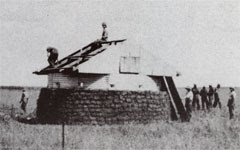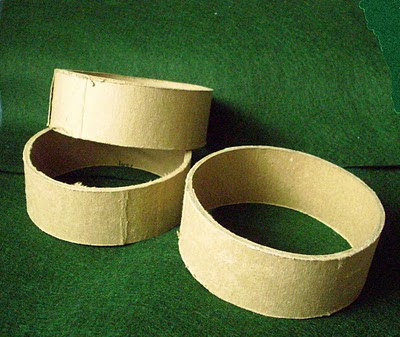This is a barrier designed to keep large wild animals - and hostile humans - out of the village and domestic animals in. Anyone who has spent time in a hot climate knows how enclosed spaces exposed to direct sunlight can be terrible heat traps. Gapped palisades like this are the African answer to that problem. The spacing between uprights is sufficient to form a barrier to man and beast while allowing the wind to pass through. Although not as effective a defense against archery or gunfire as a solid palisade, it still offers a good deal of cover, and a means by which defenders can shoot out of the village without exposing themselves too much.
I use the mini-dowels available from Michael's hobby stores for the stakes, and popsicle sticks from the same source for the bases. Two packs of dowels should be sufficient to enclose five of the huts I made earlier. The crossbars are bamboo kabob skewers split lengthwise.

 Use fifteen or sixteen dowels to make a two inch length of palisade, spacing each a sixteenth of an inch or so apart. Any irregularity in the spacing is fine; such palisades are seldom perfectly measured in real life.
Use fifteen or sixteen dowels to make a two inch length of palisade, spacing each a sixteenth of an inch or so apart. Any irregularity in the spacing is fine; such palisades are seldom perfectly measured in real life. All the dowels are lined up and the crossbars glued in place using ordinary craft adhesive. Tip: Put the glue on the crossbars, not the uprights, otherwise it'll dribble down between the dowels and stick them to the work surface! The strip of card to the left acts as a ruler for positioning the crossbars so they're consistent with all the palisade sections.
All the dowels are lined up and the crossbars glued in place using ordinary craft adhesive. Tip: Put the glue on the crossbars, not the uprights, otherwise it'll dribble down between the dowels and stick them to the work surface! The strip of card to the left acts as a ruler for positioning the crossbars so they're consistent with all the palisade sections. Finally, once the crossbars are set, glue a short length of popsicle stick to a matching strip of thin card, cutting the ends at angles to allow the palisade to curve. You can glue the palisade length to the top of the popsicle stick as shown even if it's still wet. I hold the new section upright by placing a length of kabob skewer or a popiscle stick atop it and resting on an already completed length of palisade. The three-inch length behind the new strip will form one side of a section containing the gate, which I'll make later. I've already covered the base of this with a mix of spackle and florists' sand. Once all is complete I'll post some photos of it in situ.
Finally, once the crossbars are set, glue a short length of popsicle stick to a matching strip of thin card, cutting the ends at angles to allow the palisade to curve. You can glue the palisade length to the top of the popsicle stick as shown even if it's still wet. I hold the new section upright by placing a length of kabob skewer or a popiscle stick atop it and resting on an already completed length of palisade. The three-inch length behind the new strip will form one side of a section containing the gate, which I'll make later. I've already covered the base of this with a mix of spackle and florists' sand. Once all is complete I'll post some photos of it in situ. 









 With its companion steam exploration vehicle, for comfort and security in hostile climes.
With its companion steam exploration vehicle, for comfort and security in hostile climes. Last but not least, a warband of twenty Apache Indians, again suitable for Victorian sci-fi or plain old Plains Wars.
Last but not least, a warband of twenty Apache Indians, again suitable for Victorian sci-fi or plain old Plains Wars.
